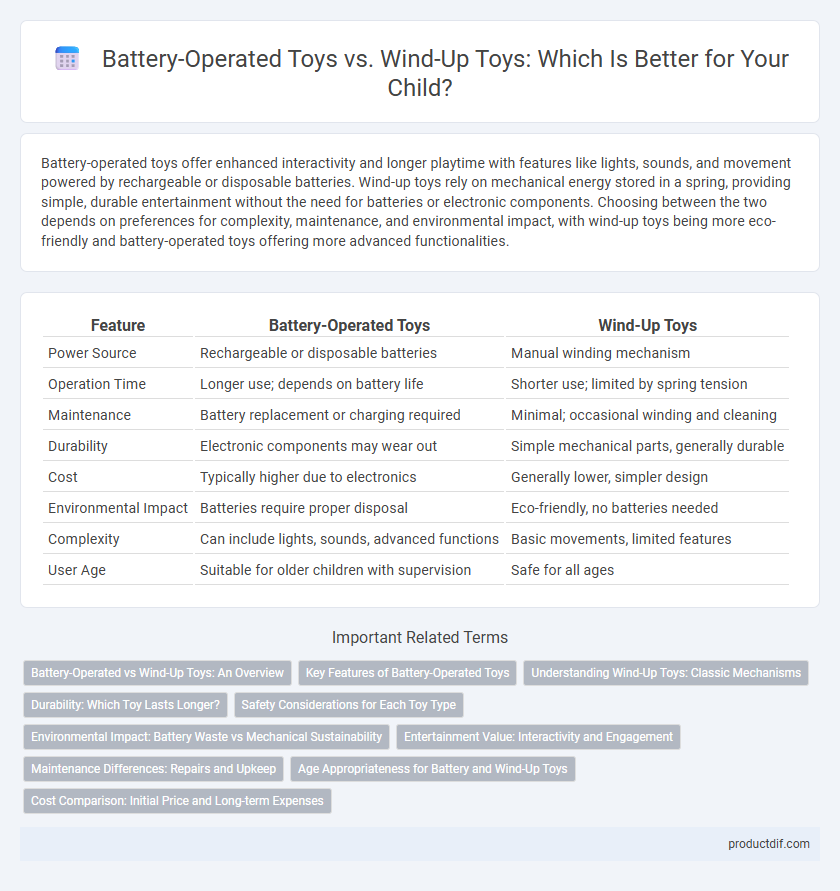Battery-operated toys offer enhanced interactivity and longer playtime with features like lights, sounds, and movement powered by rechargeable or disposable batteries. Wind-up toys rely on mechanical energy stored in a spring, providing simple, durable entertainment without the need for batteries or electronic components. Choosing between the two depends on preferences for complexity, maintenance, and environmental impact, with wind-up toys being more eco-friendly and battery-operated toys offering more advanced functionalities.
Table of Comparison
| Feature | Battery-Operated Toys | Wind-Up Toys |
|---|---|---|
| Power Source | Rechargeable or disposable batteries | Manual winding mechanism |
| Operation Time | Longer use; depends on battery life | Shorter use; limited by spring tension |
| Maintenance | Battery replacement or charging required | Minimal; occasional winding and cleaning |
| Durability | Electronic components may wear out | Simple mechanical parts, generally durable |
| Cost | Typically higher due to electronics | Generally lower, simpler design |
| Environmental Impact | Batteries require proper disposal | Eco-friendly, no batteries needed |
| Complexity | Can include lights, sounds, advanced functions | Basic movements, limited features |
| User Age | Suitable for older children with supervision | Safe for all ages |
Battery-Operated vs Wind-Up Toys: An Overview
Battery-operated toys offer continuous playtime and enhanced functionality through electric motors powered by rechargeable or replaceable batteries, enabling features like sound, motion, and lights. Wind-up toys rely on mechanical energy stored in a spring, requiring manual winding, which limits playtime but encourages fine motor skills and simple engineering understanding. Both toy types hold unique appeal, with battery-operated options favored for interactive experiences and wind-up toys appreciated for their simplicity and durability.
Key Features of Battery-Operated Toys
Battery-operated toys offer enhanced functionality through powered motors and electronic components, enabling lights, sounds, and motion for interactive play. These toys typically run on rechargeable or disposable batteries, providing extended playtime without manual effort. Advanced features such as remote control, programmable actions, and sensor integration distinguish battery-operated toys from traditional wind-up options.
Understanding Wind-Up Toys: Classic Mechanisms
Wind-up toys operate using a coiled spring mechanism that stores potential energy when wound, which then powers the toy's movement as the spring unwinds. These classic toys rely on mechanical precision and craftsmanship, often featuring gears and cams to produce specific motions or sounds without the need for batteries. The durable, eco-friendly design of wind-up toys makes them timeless collectibles that highlight the ingenuity of pre-electric toy engineering.
Durability: Which Toy Lasts Longer?
Battery-operated toys usually have electronic components that may wear out faster than the mechanical parts of wind-up toys, impacting overall durability. Wind-up toys rely on simple gears and springs, often resulting in a longer lifespan due to fewer breakable elements. However, exposure to moisture and dust can affect wind-up mechanisms, while battery corrosion remains a common issue for battery-operated toys.
Safety Considerations for Each Toy Type
Battery-operated toys require careful attention to battery compartment security to prevent access by young children, reducing the risk of choking or chemical exposure. Wind-up toys are generally safer in terms of power sources, but their small parts and winding mechanisms can pose strangulation or pinching hazards, especially for toddlers. Ensuring toys meet ASTM F963 safety standards and regularly inspecting for damaged components can minimize risks associated with both battery-operated and wind-up toys.
Environmental Impact: Battery Waste vs Mechanical Sustainability
Battery-operated toys often contribute to environmental pollution due to the disposal of toxic battery components and limited recycling options. Wind-up toys rely on mechanical energy, producing zero electronic waste and offering a more sustainable alternative by reducing reliance on disposable power sources. Choosing wind-up toys helps minimize environmental impact and promotes eco-friendly playtime solutions.
Entertainment Value: Interactivity and Engagement
Battery-operated toys often provide higher entertainment value through interactive features like lights, sounds, and motion, enhancing engagement and playtime excitement. Wind-up toys offer a more hands-on experience, requiring manual operation that encourages fine motor skills and imaginative play. Both types stimulate different aspects of a child's development but battery-operated toys generally deliver more dynamic and sustained interaction.
Maintenance Differences: Repairs and Upkeep
Battery-operated toys require regular battery replacements and occasional circuit checks to maintain optimal performance, while wind-up toys primarily need mechanical cleaning and lubrication to prevent gears from jamming. Electronic components in battery-operated toys are more susceptible to damage from moisture and require careful handling during repairs, unlike wind-up toys, which have simpler, more durable mechanical parts. Overall, maintenance of wind-up toys tends to be less frequent and more straightforward compared to the ongoing technical upkeep necessary for battery-operated toys.
Age Appropriateness for Battery and Wind-Up Toys
Battery-operated toys are generally suitable for children aged three and above due to small parts and electronic components that require basic motor skills and safety awareness. Wind-up toys often cater to younger children, typically ages two and up, as their simpler mechanical design encourages fine motor development without the need for batteries or complex operations. Selecting age-appropriate toys ensures both safety and engagement, enhancing learning and play experiences.
Cost Comparison: Initial Price and Long-term Expenses
Battery-operated toys generally have a higher initial price due to electronic components and require ongoing costs for batteries, which can add up over time. Wind-up toys tend to be more affordable upfront and have minimal long-term expenses since they operate mechanically without the need for batteries. When comparing cost efficiency, wind-up toys offer better long-term value despite their simpler design.
Battery-operated toys vs wind-up toys Infographic

 productdif.com
productdif.com